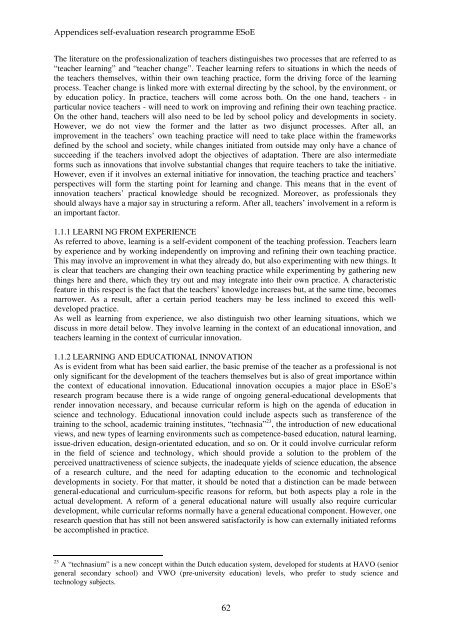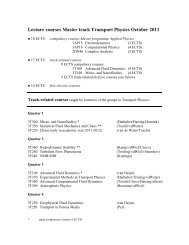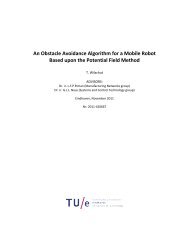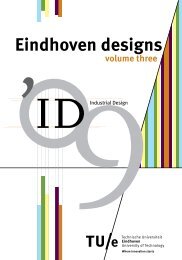Self-evaluation - Technische Universiteit Eindhoven
Self-evaluation - Technische Universiteit Eindhoven
Self-evaluation - Technische Universiteit Eindhoven
You also want an ePaper? Increase the reach of your titles
YUMPU automatically turns print PDFs into web optimized ePapers that Google loves.
Appendices self-<strong>evaluation</strong> research programme ESoE<br />
The literature on the professionalization of teachers distinguishes two processes that are referred to as<br />
“teacher learning” and “teacher change”. Teacher learning refers to situations in which the needs of<br />
the teachers themselves, within their own teaching practice, form the driving force of the learning<br />
process. Teacher change is linked more with external directing by the school, by the environment, or<br />
by education policy. In practice, teachers will come across both. On the one hand, teachers - in<br />
particular novice teachers - will need to work on improving and refining their own teaching practice.<br />
On the other hand, teachers will also need to be led by school policy and developments in society.<br />
However, we do not view the former and the latter as two disjunct processes. After all, an<br />
improvement in the teachers’ own teaching practice will need to take place within the frameworks<br />
defined by the school and society, while changes initiated from outside may only have a chance of<br />
succeeding if the teachers involved adopt the objectives of adaptation. There are also intermediate<br />
forms such as innovations that involve substantial changes that require teachers to take the initiative.<br />
However, even if it involves an external initiative for innovation, the teaching practice and teachers’<br />
perspectives will form the starting point for learning and change. This means that in the event of<br />
innovation teachers’ practical knowledge should be recognized. Moreover, as professionals they<br />
should always have a major say in structuring a reform. After all, teachers’ involvement in a reform is<br />
an important factor.<br />
1.1.1 LEARNI NG FROM EXPERIENCE<br />
As referred to above, learning is a self-evident component of the teaching profession. Teachers learn<br />
by experience and by working independently on improving and refining their own teaching practice.<br />
This may involve an improvement in what they already do, but also experimenting with new things. It<br />
is clear that teachers are changing their own teaching practice while experimenting by gathering new<br />
things here and there, which they try out and may integrate into their own practice. A characteristic<br />
feature in this respect is the fact that the teachers’ knowledge increases but, at the same time, becomes<br />
narrower. As a result, after a certain period teachers may be less inclined to exceed this welldeveloped<br />
practice.<br />
As well as learning from experience, we also distinguish two other learning situations, which we<br />
discuss in more detail below. They involve learning in the context of an educational innovation, and<br />
teachers learning in the context of curricular innovation.<br />
1.1.2 LEARNING AND EDUCATIONAL INNOVATION<br />
As is evident from what has been said earlier, the basic premise of the teacher as a professional is not<br />
only significant for the development of the teachers themselves but is also of great importance within<br />
the context of educational innovation. Educational innovation occupies a major place in ESoE’s<br />
research program because there is a wide range of ongoing general-educational developments that<br />
render innovation necessary, and because curricular reform is high on the agenda of education in<br />
science and technology. Educational innovation could include aspects such as transference of the<br />
training to the school, academic training institutes, “technasia” 23 , the introduction of new educational<br />
views, and new types of learning environments such as competence-based education, natural learning,<br />
issue-driven education, design-orientated education, and so on. Or it could involve curricular reform<br />
in the field of science and technology, which should provide a solution to the problem of the<br />
perceived unattractiveness of science subjects, the inadequate yields of science education, the absence<br />
of a research culture, and the need for adapting education to the economic and technological<br />
developments in society. For that matter, it should be noted that a distinction can be made between<br />
general-educational and curriculum-specific reasons for reform, but both aspects play a role in the<br />
actual development. A reform of a general educational nature will usually also require curricular<br />
development, while curricular reforms normally have a general educational component. However, one<br />
research question that has still not been answered satisfactorily is how can externally initiated reforms<br />
be accomplished in practice.<br />
23 A “technasium” is a new concept within the Dutch education system, developed for students at HAVO (senior<br />
general secondary school) and VWO (pre-university education) levels, who prefer to study science and<br />
technology subjects.<br />
62

















